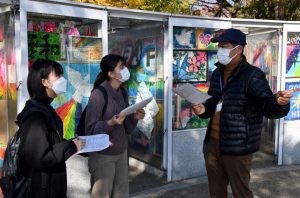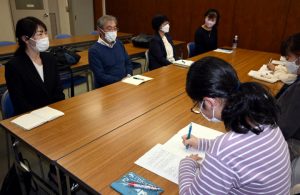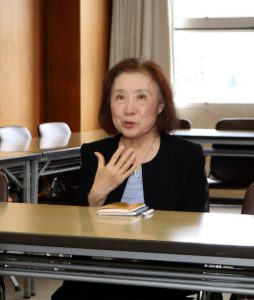Junior Writers Reporting: Five months to the Hiroshima Summit
Dec. 19, 2022
Conveying the memories of the atomic bombing in foreign language
The summit meeting of the G7 (The Group of Seven industrialized nations) will begin on May 19 of next year, just five months from now, in Hiroshima City, to which the leaders and the government officials of the seven nations, including Japan, the United States and the United Kingdom, and many press people are coming. It is expected that Hiroshima will attract attention and the number of visitors from abroad will increase greatly, creating more opportunity to tell of the damage caused by the atomic bombing and the A-bomb survivors’ wish for a world free from nuclear weapons through various foreign languages.
Junior writers will report on the Summit-related topics and people’s efforts, as well as exploring questions, through May. In this article, we will introduce people who speak about the atomic bombing of Hiroshima in English.
HIP
Fully realized the importance of practicing to introduce A-bomb monuments in Peace Park
In and around Peace Memorial Park, where Hiroshima Peace Memorial Museum is located, there are monuments to console the souls of the victims of the atomic bombing. Hiroshima Interpreters for Peace (HIP, headed by Keiko Ogura) is a citizens’ volunteer group that guides foreign tourists on English-language tours around the park.
HIP was founded in 1984, with about 200 members ranging from elementary school students to specialists in the English language. Kazuhiko Futagawa, 76, was exposed to the bombing while in his mother’s womb. He was interested in studying English, but never used the language in his work. With advice from Ms. Ogura, he decided to share his A-bomb account in English, and studied very hard.
He speaks about his family’s A-bomb experience because he does not have his own. He realizes it becomes more convincing with personal anecdotes when telling his story directly in English.
Ten junior writers had an opportunity to act as a guide after we had a lesson with HIP.
We divided into groups, and walked in the park for an hour and a half, visiting eight to 10 monuments including the Cenotaph for the A-bomb Victims and Children’s Peace Monument. Shinichi Sato, 61, a member of HIP, explained the background of the erection of the monuments in English, then we repeated what he said aloud. It was hard to pronounce difficult words such as “hypocenter.”
He taught us the points to remember when we introduce the monuments, which are; memorize the name of the monument and the year it was built; make sure to show the Cenotaph for the A-bomb Victims, the Atomic Bomb Dome and Children’s Peace Monument; and be careful where you stand to keep out of the way of the visitors.
While they halted activities due to the COVID-19 outbreak, which began in 2020, they created an English website, posting videos to introduce the monuments for those who cannot visit Hiroshima.
We felt their “seriousness to convey” their message by overcoming the language barrier. The experience of guiding, which was unexpectedly difficult, made us feel keenly the necessity of studying and practicing. We realized the significant role played by HIP, which sends out a message of peace in English.
HIGA
Language experts with the spirit of hospitality
Hiroshima Interpreters & Guide Association (HIGA) is an organization comprised of 234 professional tour guides and interpreters, officially known as “National Government Licensed Guide Interpreters,” covering eight languages, including English and French.
We interviewed four members who are fluent in English; Masako Unezaki, 64, President of HIGA; Tetsuhiro Murakami, 71; Yoshimi Nakao, 61; and Remi Kawamura, 46.
HIGA members guide various guests, from independent travelers to a group of cruise ship travelers from abroad, to Peace Memorial Park, Miyajima and a lot of other places. Mr. Murakami thinks “the world’s impression of Hiroshima depends on the guides who introduce the city” and tries to have a conversation with them respecting their diverse values.
They were also involved in international conferences. When the G7 Foreign Ministers’ Meeting was held in Hiroshima in April 2016, they actively cooperated by arranging the hospitality program for the foreign ministers.
Hiroshima is globally known as the A-bombed city, which receives people who wish to understand the true consequences of the atomic bombing, including those from the United States, the country which dropped the atomic bomb, and who believe that “it was a necessary thing.” Showing these guests around is one-of-a-kind experience that the guides in other parts of Japan do not usually have. Ms. Kawamura said, “I think about the A-bomb victims when I communicate our desire for peace to whoever I give a tour.”
HIGA also provides training to taxi companies and tourism-related businesses in Hiroshima Prefecture, in which they explain religious dietary restrictions and how to use a translation app, which is useful for simple communication. “We would like to spread the spirit of hospitality throughout Hiroshima,” Ms. Unezaki said enthusiastically.
We see some foreign tourists coming back to the city center recently. Ms. Nakao said, “Tourists from abroad feel assured just by being talked to with a smile.” There are things we can do to make travelers wish to visit Hiroshima again.
A-bomb Legacy Successors
Create a future by squarely facing history
“A-bomb Legacy Successors” are those who speak about the experience of “that day” on behalf of the aged survivors. Toshiko Okamoto, 69, resident of Fuchu Town in Hiroshima Prefecture, is one of the Successors who took over the A-bomb experience of the late Takashi Teramoto and Taeko Teramae. She shares their story to foreign tourists in English.
Ms. Okamoto, who has lived in the United States and is good with English, moved to Hiroshima from Tokyo about three decades ago. Since then, she has been learning about Hiroshima “wanting to explain about the atomic bombing to people from around the world.” She also works as a Peace Volunteer who offers a guided tour at Hiroshima Peace Memorial Museum.
She says talking to non-Japanese visitors directly in English further deepens communication, and “finds it rewarding when the audience sympathize with the belief that ‘Nuclear weapons must not be used.’”
When she explains painful experiences of the survivors and the tremendous damage caused by the bombing, people from the United States ask nervously if Japanese people hold a grudge against their country. Some even shed tears. Ms. Okamoto responds, “Let’s join hands together and think about the future so that war will never happen again.”
One day, a woman from Vietnam gave Ms. Okamoto a grim look while she was giving a survivor’s testimony, which she thought might be because of the history of the invasion of countries in Asia by the Imperial Japanese Army. Reflecting back, she said, “That experience made me realize the importance of learning the history of our own country in order to convey the damage cause by the atomic bombing.”
To know overseas people’s views on the war is to understand the history of Japan. Ms. Okamoto and other volunteers are working while thinking about how to convey the A-bomb survivors’ wish for peace in a way that resonates with the audience. We felt that the effort and action of each one of us create a peaceful future, whether the language we speak is English or Japanese.
Keywords
G7 Summit
An international meeting attended by the leaders of The Group of Seven (G7) industrialized nations which is held every year. The members are Japan, the United States, the United Kingdom, France, Germany, Italy, and Canada. The European Union also participates in G7 Summit meetings to discuss such global issues as politics, the economy, and global warming.
With attendance of the nuclear-weapon states, whether nuclear disarmament and non-proliferation becomes one of the topics of discussion is being watched. At this year’s meeting held in Schloss Elmau, Germany, the Russian invasion of Ukraine was also discussed by the G7 Leaders. Japan chairs the G7 Summit next year, and Prime Minister Fumio Kishida has announced that it will be held in Hiroshima from May 19 to 21.
The above article was written by the following junior writers:
Yotsuba Sata, 18; Yuno Nakashima, 16; Aoi Miki, 17; Shino Taguchi, 16; Mei Kobayashi, 16; Misuzu Mori, 15; Riko Soma, 14; Sakura Tanimura, 14; Yukari Kobayashi, 15; Karin Fujiwara, 15; Mao Tonoshige, 14; Rio Tonoshige, 14; Miu Toda, 14; Yuko Yamashita, 14; Gaku Watanabe, 13; and Naho Sato, 13.
(Originally published on December 19, 2022)










